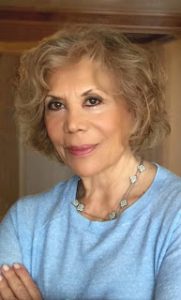Cultural Corner
Mehri Danielpour – The Starving Artist and the Queen
By Angela Shaw
At first, Mehri Danielpour could not get the hang of color. Although her mother was a painter, Mehri did not inherit her grasp of the integration of hues and dyes.
It wasn’t until age 18—when Mehri traveled to Italy to study art—that she found her medium. She says, “I was bad with color and paints. But when I saw Italian sculpture, I said, ‘This is what I want to do!’ I fell in love with sculpture.” Without a doubt, she found her niche.
That was the beginning of her artistic career. She continued her training for a six-month session at the Art Students League in New York York and also studied under John Terken. Other than that, she was self-taught—and obviously, very gifted.
Born in Iran, Mehri and her family immigrated to America shortly after WWII when she was eight years old. The 5-month-long trip started through India. The family boarded an American military ship that took them from Mumbai to San Pedro. From there, they traveled to New York where friends resided. Mehri got married and eventually settled in Palm Beach in 1965.
Her husband was a businessman and a poet and treated her royally. He wrote her a poem a day until he lost the use of his hands due to Multiple Sclerosis. His condition forced Mehri to find a way to make a living. Sculpture was what she knew, so she transformed her ‘hobbyist’ art form into a professional trade. Since her husband had so lovingly spoiled her, she also had to quickly acquire a few life skills—like writing a check!
After setting her mind to a professional sculpting career, Mehri experienced ‘miracle after miracle,’ as she puts it. In her early art days, she had always dreamt of sculpting the Iranian Royal Family. Shortly after her career launch, she received a call from the Iranian Embassy. Someone had seen one of her sculptures in Brazil and requested her portfolio. Well, she didn’t have a portfolio but quickly went to work on compiling photos of her best work. It was followed by a commission to sculpt the Shah and Queen Farah Pahlavi.
Mehri’s dream and her artistic goal had come true.
But it didn’t end there. The Queen kept calling Mehri to ask about her kids and invited her to come to Washington DC for a visit on the Potomac. She was also included in the 1971 celebration of the 2,500th year of the Persian Empire—the most expensive party ever! The Queen used her portrait bust, sculpted by Mehri, as a gift for all her guests. Mehri mused on that irony that she, a starving artist, had become friends with a royal Queen!

Mehri’s style ranges from realistic to abstract. Rarely does an artist excel in both arenas. She defies genre stereotypes. Her artwork has been displayed in several shows including a 1976 exhibit with Andy Warhol at the Colony Hotel in Palm Beach. She recently did busts of Tommy Hilfiger’s wife and son.

A favorite of hers—“The Year of the Child”—once stood at the former site of the West Palm Beach library on Flagler Boulevard. It now stands in the trendy Northwood area.

Mehri doesn’t sketch before sculpting. She goes directly to clay on an armature. There is no measuring of the subject. All her carving is done “Eye-to-Hand.” She has a very good eye!
Sculpture is a multi-tiered process that relies on metal foundries. Mehri utilizes foundries in Sarasota and Miami. She also used one in Riviera Beach, but it has since closed down. A bust can take three to four 1-1/2 hour sittings where Mehri chisels away at her clay.
Next, a rubber mold is made. Liquid wax is poured into the rubber mold. A porcelain mold is created from the wax mold. The wax is melted, and then molten bronze is poured into the porcelain mold. After the bronze hardens, the porcelain is broken to reveal the final form. Much cleaning and polishing follow. Then a colored patina is applied and heated with a torch to finish off the piece.

Mehri also works in crystal Lucite. Her Wild Horses is a stunning example of her use of this material.
“Escape” is Mehri’s own masterpiece and was inspired by those escaping Florida’s 1928 hurricane. However, she says it can apply to any scenario of the same subject.

Discover more of Mehri’s work on her website and enjoy the beauty and restoration her artwork exudes. I think you’ll agree she is a queen in her own right!
Mehri Danielpour’s contact is (561-333-2312).


